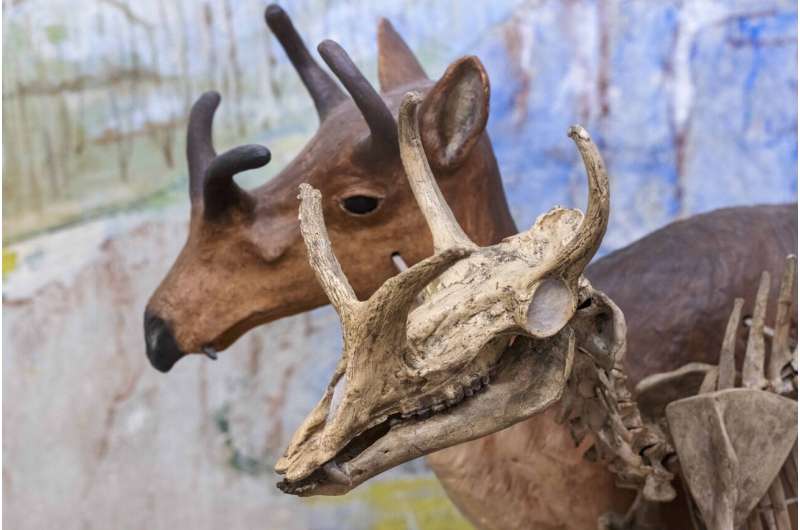
Syndyoceras existed for 4.2 million years during the Cenozoic Era on the North American continent. This skeleton is on display at the University of Nebraska State Museum–Morill Hall in Lincoln, Nebraska. Credit: Craig Chandler, University Communications and Marketing, University of Nebraska–Lincoln
To understand the present, it helps to look at history. New research from the University of Nebraska-Lincoln examined fossils dating back 66 million years and tracked changes in mammal ecosystems and species diversity across the North American continent.
The study, led by Alex Shupinski, who received his PhD in May, and co-authored by Kate Lyons, an associate professor in the School of Biological Sciences, provides a large-scale view of how species diversity changed over the first 65 million years of the Cenozoic Era — until the arrival of humans — and how climate and other environmental factors, including landscape changes, affected animal life on the continent.
The results published in Proceedings of the Royal Society B They also provide insight into how mammals rebounded after the last mass extinction event: the eradication of non-avian dinosaurs.
“Sixty-six million years ago, we went from a completely subtropical environment in North America to grasslands, then to a frozen savannah, and finally to the Ice Age,” Shupinski said. “This shows how species have changed over time, through many ecological, environmental and climatic changes, and it allows us to compare these events and at different spatial scales.”
The researchers sliced the fossil record from the Cenozoic era into multi-million-year slices and used three indices of functional diversity – which quantify changes in community structures using mammal traits – to examine mammal communities at local and continental scales.
For most of the Cenozoic era, local and continental measures of functional diversity differed, but surprisingly, during the first 10 million years of the era, immediately after the extinction of non-avian dinosaurs, all measures of functional diversity, both locally and across the continent, increased.
“It was fascinating to see that for most of the Cenozoic, functional diversity was decoupled across time and spatial scales, except this time,” Shupinski said.
“For 10 million years, all the measures evolve in the same way. Then, about 56 million years ago, we see this massive immigration of mammals into North America from other continents, and at that point we see a divergence in functional diversity.
“Communities are evolving at different times, at different paces and in different directions,” she said. “We can see that diversity of roles is increasing at the local level, but decreasing at the continental level.”
Lyons said some of the changes among mammal species can be explained by environmental changes, including periods of cooling and warming or when heavily forested areas were usurped by grasslands, but that large-scale environmental changes have not reached the level of disruption caused by the mass extinction of the dinosaurs.
“So this could potentially be a way to identify areas of the globe or communities that are under particular stress,” Lyons said.
“We may be entering a sixth mass extinction, and if so, we might expect to see communities at the forefront of this extinction respond in similar ways, based on the patterns we see after the extinction of non-avian dinosaurs.”
In the field of conservation paleobiology, tracking past changes in ecosystems over long periods of time helps scientists and the public better understand biodiversity crises occurring today, and this current study offers an in-depth look at the age of mammals and provides insights into what might happen next.
“If we look at modern crises and we see a similar response in the functional diversity of modern community structures, that can be a conservation tool because we can highlight some of those communities that are experiencing the most disruption and are most at risk of change and disruption to their ecological services and functions,” Shupinski said.
The study’s other authors are Peter Wagner, a professor of earth and atmospheric sciences at Nebraska, and Felisa Smith of the University of New Mexico in Albuquerque.
More information:
Alex B. Shupinski et al., Unique functional diversity during the early Cenozoic mammalian radiation in North America, Proceedings of the Royal Society B: Biological Sciences (2024). DOI: 10.1098/rspb.2024.0778
Provided by the University of Nebraska-Lincoln
Quote: Mammalian diversity research spans 66 million years (July 17, 2024) retrieved July 18, 2024 from https://phys.org/news/2024-07-tracks-million-years-mammalian-diversity.html
This document is subject to copyright. Apart from any fair dealing for the purpose of private study or research, no part may be reproduced without written permission. The content is provided for informational purposes only.